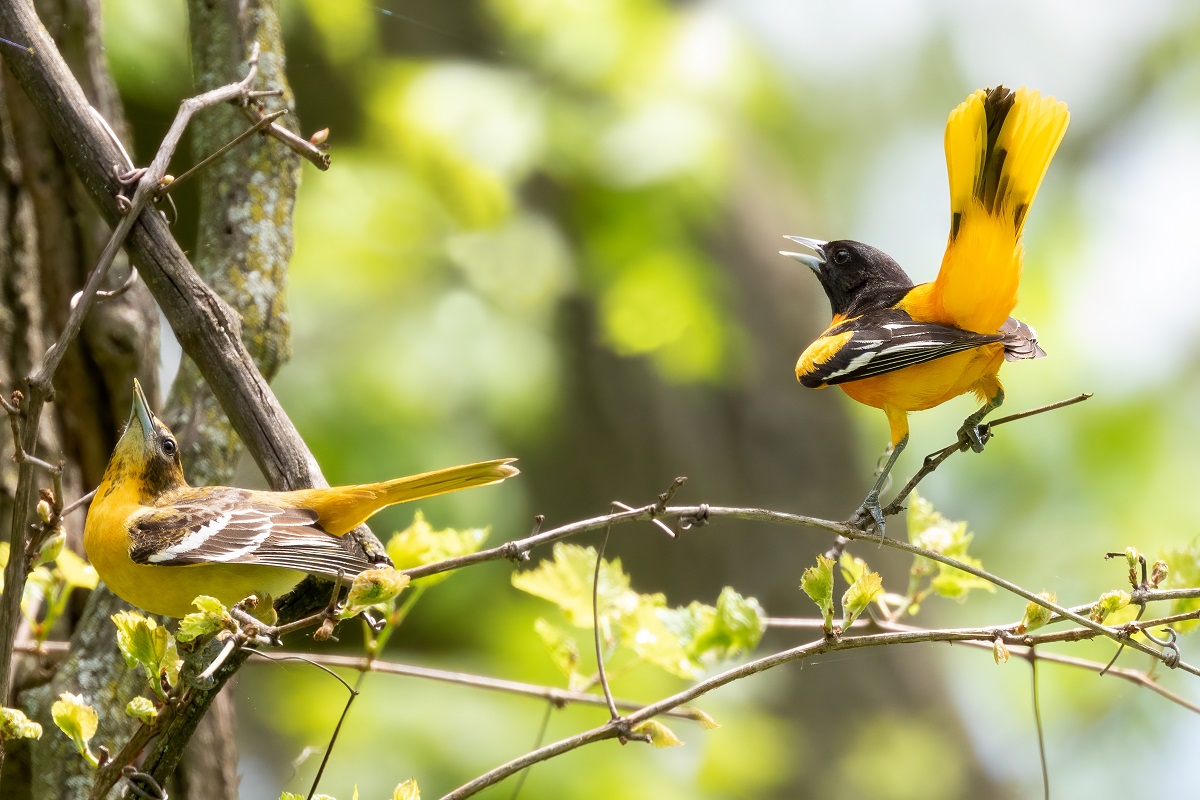Orioles travel annually from wintering grounds in Central America and South America to North America where they mate after a courting ritual and raise their brood before heading south. They are often monogamous to one partner during a breeding season.
Spotting a Baltimore oriole is always a treat. With their lovely warbling songs, bright orange feathers, and their love of fruit, they are a delightful addition to any backyard space.
Orioles are long-distance migrants that travel from wintering grounds in Central America and South America to North America for their abridged breeding season. Once they arrive in North America, they raise one brood of birds before heading south mid-summer.
Keep reading if you have ever wondered about the Baltimore orioles’ mating habits, nesting, and eggs!
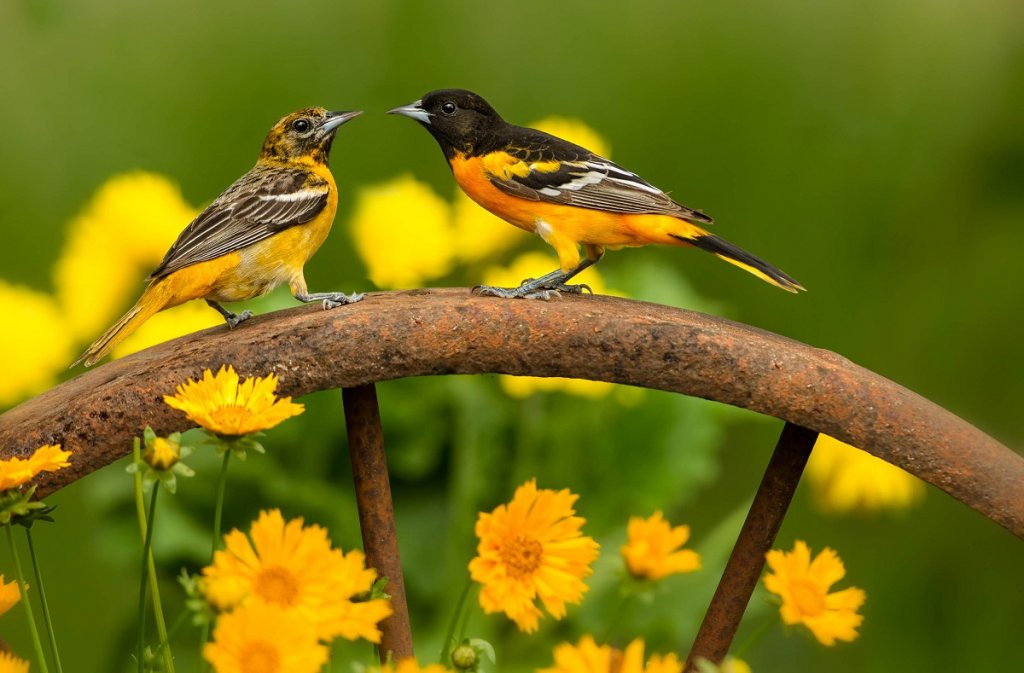
Baltimore Oriole Identification
Baltimore orioles (Icterus galbula) can be identified by their bright orange plumage, black head, and white wing bars. For birdwatchers looking to catch a glimpse of these striking orange birds, it’s best to keep your eyes high in the trees. Baltimore orioles nest high in the branches of deciduous trees, like elms, maples, and cottonwoods.
Their warbling songs can be heard late in the springtime, and they are a member of the dawn chorus. Baltimore oriole songs are heard primarily in the early portion of the breeding season and fade as the season progresses.
Female Baltimore Oriole
Unlike the male Baltimore oriole, the female doesn’t have the same striking orange plumage. Female Baltimore orioles can be identified by their muted orange to olive green coloring that covers their breast, head, and underparts. The lack of black feathers makes them stand apart from the male. They have a yellow tail and more white accents on their wing bars.
At a glance, the female oriole is almost identical to juvenile male and female orioles. As the female oriole ages, her drab orange plumage intensifies with color every year. If she lives long enough, her feathers can be as bright as the males!
Male Baltimore Oriole
Male Baltimore orioles are hard to miss. Their bright orange plumage on their rump, breast, and underparts stands in stark contrast in tree branches. Unlike female orioles, the male has an all-black head, streaks of black in their tail feathers, and white and black wing bars.
It’s important to note that juvenile male orioles don’t establish their bright orange plumage until their second year. While their bright colors are a way to attract females, some male orioles don’t mate for two years until they establish their bright colors.
Mating Season and Location
The mating season for these songbirds is shorter than most wild birds. They return from their wintering grounds in early May, and their breeding season typically ends around July. In the winter months, they live in warmer temperatures where food is plentiful in places such as Florida, Mexico, and as far south as Central America and South America. When they migrate north, they breed in the eastern and midwestern portions of the United States in deciduous trees as far north as Canada.
Courtship Rituals
During the breeding season, male orioles attract mates and fiercely defend their territories with their long, warbling songs. The Baltimore orioles song consists of clear, liquid notes of repeating tones that last a few seconds. Female Baltimore orioles sing, too. Mated pairs of orioles often sing as a duet during courtship to locate each other while nesting.
During the day, the male keeps singing until he gains the attention of a female. If he is not successful one day, he will not sing until the next day. Once the birds become a couple, the intense singing ceases.
To attract a female, the male oriole puts on quite a show, as he sings, chatters, & hops from branch to branch to impress them. He may also bow as he fans his tail and lowers and flutters his wings. A responsive female may quiver her wings and sing in response or ignore the potential suitor and acrobatic performance.
Mating Practices
The male bird does not have a penis, but both sexes have a cloaca, an opening in their bodies that is swollen during breeding season. The male hops on top of the female who moves her tail feathers out of the way as the male rubs his cloaca against hers so that she can transfer semen. Birds have sex many times during breeding season.
Baltimore orioles are generally monogamous during a mating season but do not mate for life. Both the male can female may engage in EPC or extra-pair copulation with another bird. Studies of various species of bird indicate that successful egg fertilization may result from copulation with the extra-pair male – a phenomenon that may occur with Baltimore orioles too.
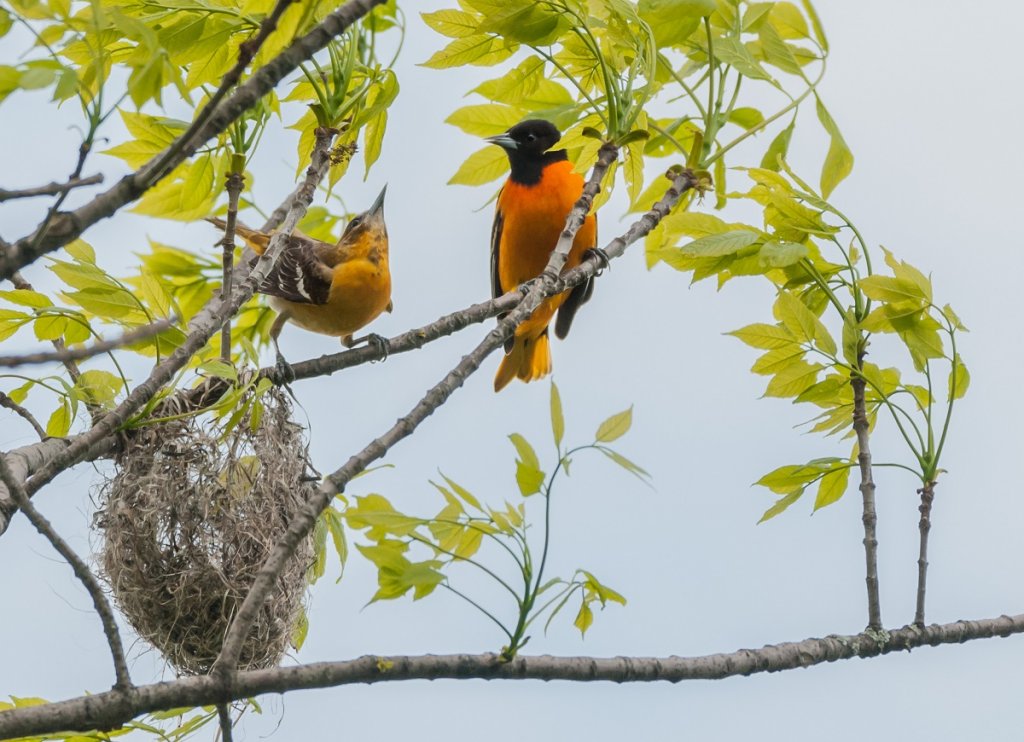
Baltimore Oriole Nests
The nest of the Baltimore oriole isn’t your average songbird nest. Their hanging nests demonstrate their exceptional weaving skills. They are constructed from nesting materials such as twigs, dried grass, twine, and sometimes even horsehair and appear as hanging pouches nestled in high branches of deciduous trees. Willow, maples, cottonwood, apple, and elm tree are particular favorite habitats.
The female oriole does most of the nest building, which requires superior architectural and weaving skills to produce a structure that might support up to 7 eggs and chicks once hatched. As Ms. Oriole builds, the male guards the territory.
Spotting a Baltimore oriole bird’s nest proves difficult for bird watchers because they are often hidden from sight in tree branches and can be as high as 60 feet off the ground!
Oriole Eggs
Baltimore oriole eggs are pale blue and accented with dark spots. Since the oriole season is relatively short compared to other songbirds, they only lay one brood of eggs per breeding season. Each brood consists of three to seven eggs, and incubation takes up to two weeks. The female primarily sits on the nest while the male sticks close by.
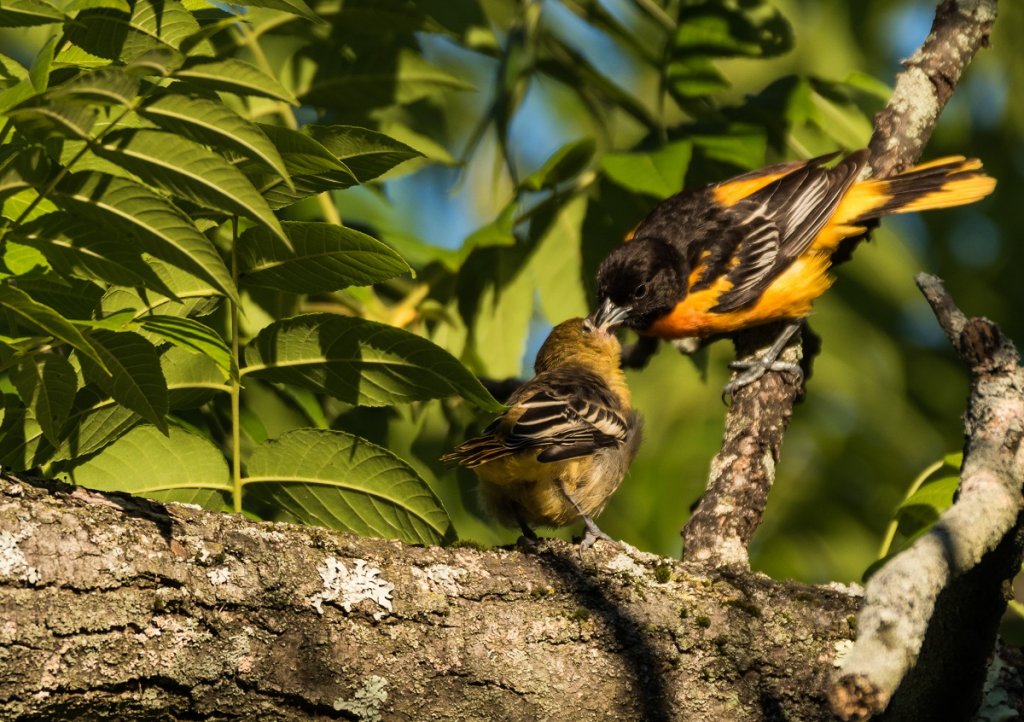
Oriole Nestlings
The nestlings remain in the nest for another two weeks after hatching. During this time, the male and female take turns feeding the young and helpless birds. Because juvenile orioles need a lot of protein, baby orioles eat a diet rich in insects and bugs during the breeding season.
Once the chicks are independent, the parents may go their separate ways, even before starting the journey to the wintering site.
Orioles are one of the few birds that don’t fall victim to the parasitic cowbird. Cowbirds often lay their eggs in the nest of other songbirds, but Oriole nests have an inner bowl so small, hidden, and intricate that cowbirds have difficulty getting inside to lay their eggs.
Do Orioles Return To The Same Nest?
These native birds of North America may return to the same nesting site but will not reuse the same nest. However, birdwatchers have spotted Baltimore orioles returning to an old nest to strip it of its nesting materials to use at a new location. While many Baltimore orioles will return to the same tree or forest year after year, they build a new nest for every breeding season.
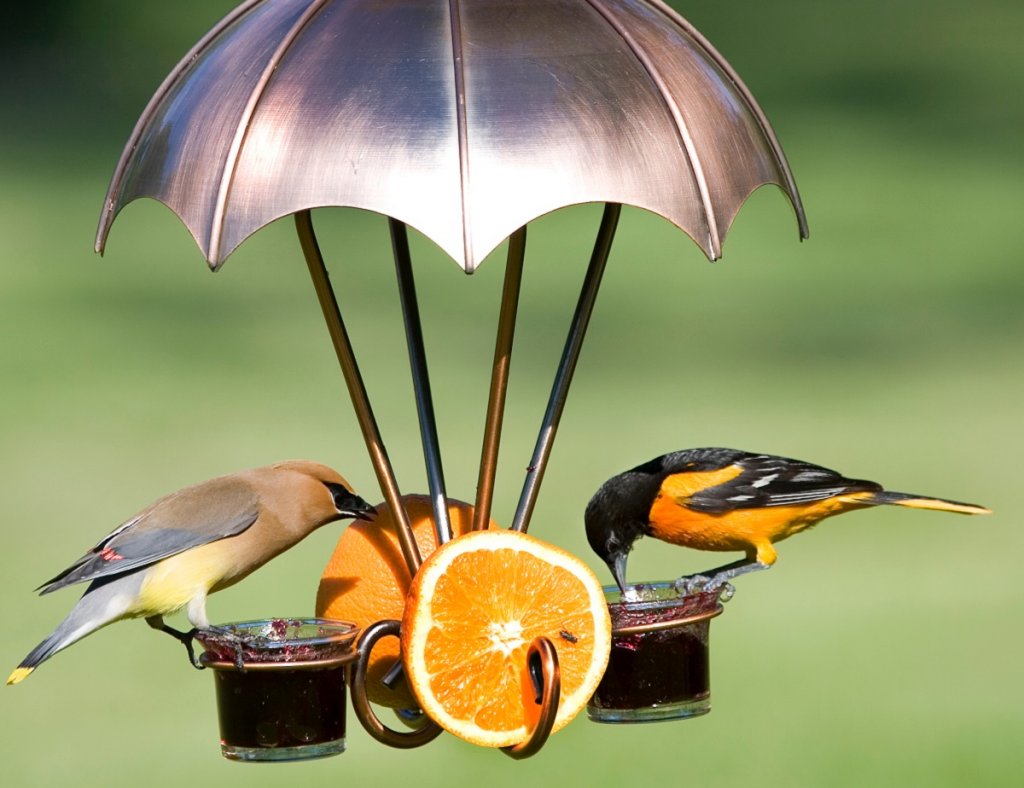
Are Orioles Territorial?
Overall, Baltimore orioles aren’t fiercely territorial birds. While other birds create dominant breeding territories, orioles are only territorial around their nests and aren’t as territorial around feeders.
Baltimore orioles aren’t the only breed of orioles that is passive regarding their breeding grounds. The Hooded oriole, Bullock’s oriole, Orchard oriole, and the Altamira oriole are all relatively passive birds regarding breeding territories. If you get too close to an oriole nest, these North American birds will chirp and chatter, but their nests are so hidden and built so high that predators rarely approach them.

